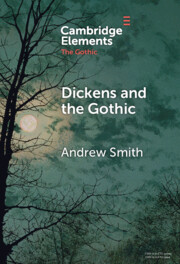Bibliography
Adorno, Theodor W., ‘On Dickens’ The Old Curiosity Shop: A Lecture’ in Rolf Tiedemann (ed.), Notes to Literature, Vol. 2 (New York: Columbia University Press, 1992), pp. 171–77.
Ballinger, Gill, ‘Haunting the Law: Aspects of Gothic in Dickens’s Fiction’, Gothic Studies, 2008, Vol. 10, No. 2, 35–50.
Bowen, John, ‘Charles Dickens and the Gothic’ in Townshend, Dale and Wright, Angela (eds.), The Cambridge History of the Gothic: Gothic in the Nineteenth Century (Cambridge: Cambridge University Press, 2020), pp. 246–64.
Brooks, Peter, ‘Repetition, and Return: Great Expectations and the Study of Plot’, New Literary History, Spring 1980, Vol. 11, No. 3, 505–26.
Crofts, Matthew, ‘Dickens’s Gothic Double: A Tale of Two Cities and Watts Phillips’s The Dead Heart’, Victoriographies, 2018, Vol. 8, No. 3, 290–306.
Dardir, Ahmed Diaa, ‘Fascination and Terror: Orientalism and the Return of the Repressed in A Tale of Two Cities and “A Christmas Tree”’, Dickens Quarterly, September 2022, Vol. 39, No. 3, 338–58. Dickens, Charles, American Notes for General Circulation (Harmondsworth:
Penguin, 1985).
Dickens, Charles, Great Expectations (Harmondsworth: Penguin, 1982).
Dickens, Charles, Bleak House (Harmondsworth: Penguin, 1985).
Dickens, Charles, ‘The Chimes’ in Slater, Michael (ed.), The Christmas Books, Vol. 1 (Harmondsworth: Penguin, 1985), pp. 148–245.
Dickens, Charles, ‘A Christmas Carol’ in Slater, Michael (ed.), The Christmas Books, Vol. 1 (Harmondsworth: Penguin, 1985), pp. 45–134.
Dickens, Charles, ‘The Haunted Man’ in Slater, Michael (ed.), The Christmas Books, Vol. 2 (Harmondsworth: Penguin, 1985), pp. 244–353.
Dickens, Charles, Oliver Twist (Harmondsworth: Penguin, 1985).
Dickens, Charles, Barnaby Rudge (Harmondsworth: Penguin, 1986).
Dickens, Charles, A Tale of Two Cities (Harmondsworth: Penguin, 1989).
Dickens, Charles, ‘“Christmas Ghosts” from “A Christmas Tree”’ in Paul Webb (Intro.), The Signalman & Other Ghost Stories (Stroud: Alan Sutton, 1990a), pp. 110–16.
Dickens, Charles, ‘The Signalman’ in Paul Webb (Intro.), The Signalman & Other Ghost Stories (Stroud: Alan Sutton, 1990b), pp. 1–13.
Dickens, Charles, ‘The Black Veil’ in Slater, Michael (ed.), Dickens’ Journalism: Sketches by Boz and Other Early Papers 1833–39 (London: Dent, 1996a), pp. 359–68.
Dickens, Charles, ‘Criminal Courts’ in Slater, Michael (ed.), Dickens’ Journalism: Sketches by Boz and Other Early Papers, 1833–39 (London: Dent, 1996b), pp. 194–98.
Dickens, Charles, ‘A December Vision’ in Slater, Michael (ed.), Dickens’ Journalism: The Amusements of the People and Other Papers: Reports, Essays and Reviews 1834–1851 (London: Dent, 1996c), pp. 306–09.
Dickens, Charles, ‘A Visit to Newgate’ in Slater, Michael (ed.), Dickens’ Journalism: Sketches by Boz and Other Early Papers 1833–39 (London: Dent, 1996d), pp. 199–210.
Dickens, Charles, ‘Nurse’s Stories’ in Slater, Michael and Drew, John (eds.), Dickens’ Journalism: The Uncommercial Traveller and Other papers 1859–70 (London: Dent, 2000a), pp. 169–80.
Dickens, Charles, The Old Curiosity Shop (Harmondsworth: Penguin, 2000b).
Dickens, Charles, Little Dorrit (Harmondsworth: Penguin, 2003a).
Dickens, Charles, The Pickwick Papers (Harmondsworth: Penguin, 2003b).
Dickens, Charles and Collins, Wilkie, The Lazy Tour of Two Idle Apprentices (New York: J.W. Lovell, 1884).
Federico, Annette R., ‘Satis House’, Literary Imagination, Vol. 21, No. 1, 63–76.
Freud, Sigmund, ‘The Uncanny’ in Dickson, Albert (ed.), Art and Literature: Jensen’s ‘Gradiva’, Leonardo Da Vinci and Other Works (Harmondsworth: Penguin, 1990), pp. 339–76.
Gillman, Susan K. and Patten, Robert L., ‘Dickens: Doubles: Twins: Twains’, Nineteenth-Century Fiction, March 1985, Vol. 39, No. 4, 441–56.
Glancy, Ruth, ‘Christmas Books and Stories’ in Jordan, John, Patten, Robert L. and Waters, Catherine (eds.), The Oxford Handbook of Charles Dickens (Oxford: Oxford University Press, 2018), pp. 191–206.
Grass, Sean, The Self in the Cell: Narrating the Victorian Prisoner (London: Routledge, 2013).
Hollington, Michael, ‘Boz’s Gothic Gargoyles’, Dickens Quarterly, 1999, Vol. 16, No. 3, 160–77.
Hutter, Albert D., ‘Nation and Generation in A Tale of Two Cities’ in Bloom, Harold (ed.), Modern Critical Interpretations: A Tale of Two Cities (New York: Chelsea House, 1987), pp. 37–56.
Malone, Cynthia N., ‘“Flight” and “Pursuit”: Fugitive Identity in Bleak House’, Dickens Studies Annual, Spring 1990, Vol. 19, 107–24.
March, Eleanor, Moran, Dominique, Houlbrook, Matt, Jewkes, Yvonne and Mahlberg, Michaela, ‘Defining the Carceral Characteristics of the “Dickensian Prison”: A Corpus Stylistics Analysis of Dickens’s Novels’, Victoriographies, 2023, Vol. 13, No. 1, 15–41.
Marcus, Steven, ‘Language into Structure: Pickwick Revisited’, Daedalus, Winter 1972, Vol. 101, No. 1, 183–202.
Mighall, Robert, A Geography of Victorian Gothic Fiction: Mapping History’s Nightmares (Oxford: Oxford University Press, 1999).
Mighall, Robert, ‘Dickens and the Gothic’ in Paroissien, David (ed.), Companion to Charles Dickens (Hoboken: Wiley-Blackwell, 2009), pp. 81–96.
Milbank, Alison, Daughters of the House: Modes of Gothic in Victorian Fiction (Basingstoke: Macmillan, 1992).
Simmons, Jr., James, R., ‘“Every Discernable Thing in It Was Covered with Dust and Mould”: Radcliffe’s Château-le-Blanc and Dickens’s Satis House’, Dickensian, Spring 1997, 11–12.
Slater, Michael, Editorial Comment on ‘A December Vision’ in Slater, Michael (ed.), Dickens’ Journalism: The Amusements of The People and Other Papers: Reports, Essays and Reviews 1834–1851 (London: Dent, 1996), pp. 305–6.
Smajic, Srdjan, ‘The Trouble with Ghost-Seeing: Vision, Ideology, and Genre in the Victorian Ghost Story’, English Literary History, 2003, Vol. 70, No. 4, 1107–35.
Smith, Andrew, ‘Colonial Ghosts: Mimicking Dickens in America’ in Horner, Avril and Zlosnik, Sue (eds.), Le Gothic (Basingstoke: Palgrave, 2008), pp. 185–200.
Smith, Andrew, The Ghost Story 1840–1920: A Cultural History (Manchester: Manchester University Press, 2010).
Smith, Andrew, Gothic Death 1740–1914: A Literary History (Manchester: Manchester University Press, 2016). Stahl D., John D., ‘The Source and Significance of the Revenant in Dickens’s “The Signal-Man”’, Dickens Studies Newsletter, 11 (1980), 98–101.
Tambling, Jeremy, ‘Prison-Bound: Dickens and Foucault’, Essays in Criticism, 1986, Vol. xxxvi, No. 1, 11–31.
Trilling, Lionel, ‘Little Dorrit’, The Kenyon Review, Autumn 1953, Vol. 15, No. 4, 577–90.
Williams, Frederick S., Our Iron Roads: Their History, Construction and Administration (London: Frank Cass, 1968).



